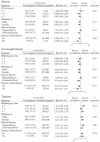Association between postterm pregnancy and adverse growth outcomes in preschool-age children
- PMID: 35544281
- PMCID: PMC9348988
- DOI: 10.1093/ajcn/nqac127
Association between postterm pregnancy and adverse growth outcomes in preschool-age children
Abstract
Background: Postterm pregnancy has been associated with higher risk of perinatal mortality and morbidity, but its long-term health effects on offspring are poorly understood.
Objectives: The aim of the study was to investigate the prospective associations between maternal postterm pregnancy and adverse growth outcomes in children.
Methods: The Jiaxing Birth Cohort is part of a large population-based health surveillance system in China and recruited pregnant females resident in the Jiaxing area between 1999 and 2013; newborns were followed up for a median duration of 5.8 y until they went to school. Mother-child pairs with maternal gestational information and offspring's anthropometric data at 4-7 y old were included. Postterm pregnancy was defined as maternal gestational age ≥42 and <47 wk, and its associations with offspring obesity, overweight/obesity, and thinness during childhood were determined by using Poisson regression models.
Results: Of the 101,505 included mother-child pairs, 2369 (2.3%) children were born at postterm. Children born at postterm had significantly lower BMI-for-age z score, weight-for-age z score, and height-for-age z score than those born at term; the mean difference (95% CI) was -0.11 (-0.15, -0.06), -0.17 (-0.21, -0.13), and -0.16 (-0.20, -0.12), respectively. When comparing postterm with term pregnancy, the multivariable-adjusted RRs and 95% CIs among preschool-age children were 0.87 (0.68, 1.11) for obesity, 0.82 (0.72, 0.94) for overweight/obesity, and 1.18 (1.09, 1.28) for thinness, respectively. These risk estimates were robust in sensitivity analyses, but were attenuated in several subgroups stratified by age, sex, mode of delivery, and fetal distress.
Conclusions: Postterm pregnancy was associated with a higher risk of thinness, and a lower risk of overweight/obesity, as well as lower growth parameters in preschool-age children. These findings imply that postterm pregnancy may impede the long-term growth of offspring.
Keywords: birth cohort; children; growth outcomes; overweight/obesity; postterm pregnancy; thinness.
© The Author(s) 2022. Published by Oxford University Press on behalf of the American Society for Nutrition.
Figures



Similar articles
-
Association between postterm birth and adverse growth outcomes in children aged 3-6 years: A national retrospective cohort study.Paediatr Perinat Epidemiol. 2025 Jan;39(1):30-40. doi: 10.1111/ppe.13122. Epub 2024 Sep 19. Paediatr Perinat Epidemiol. 2025. PMID: 39297305 Free PMC article.
-
Growth and obesity through the first 7 y of life in association with levels of maternal glycemia during pregnancy: a prospective cohort study.Am J Clin Nutr. 2016 Mar;103(3):794-800. doi: 10.3945/ajcn.115.121780. Epub 2016 Jan 27. Am J Clin Nutr. 2016. PMID: 26817507 Free PMC article.
-
Maternal Preconception Body Size and Early Childhood Growth during Prenatal and Postnatal Periods Are Positively Associated with Child-Attained Body Size at Age 6-7 Years: Results from a Follow-up of the PRECONCEPT Trial.J Nutr. 2021 May 11;151(5):1302-1310. doi: 10.1093/jn/nxab004. J Nutr. 2021. PMID: 33693757 Free PMC article. Clinical Trial.
-
Offspring body size and metabolic profile - effects of lifestyle intervention in obese pregnant women.Dan Med J. 2014 Jul;61(7):B4893. Dan Med J. 2014. PMID: 25123127 Review.
-
Long-term Risk for Type 1 Diabetes and Obesity in Early Term Born Offspring: A Systematic Review and Meta-Analysis.J Clin Endocrinol Metab. 2024 Apr 19;109(5):1393-1401. doi: 10.1210/clinem/dgad715. J Clin Endocrinol Metab. 2024. PMID: 38079466
Cited by
-
Late Arrivals, Early Health Warnings: Post-Term Birth and Adverse Weight and Metabolic Trajectories.Paediatr Perinat Epidemiol. 2025 Jan;39(1):41-42. doi: 10.1111/ppe.13154. Epub 2025 Jan 7. Paediatr Perinat Epidemiol. 2025. PMID: 39776434 Free PMC article. No abstract available.
-
Factors Associated With Post-term Birth and Its Relationship to Neonatal Mortality in Japan: An Analysis of National Data From 2017 to 2022.J Prev Med Public Health. 2024 Nov;57(6):564-571. doi: 10.3961/jpmph.24.355. Epub 2024 Sep 24. J Prev Med Public Health. 2024. PMID: 39438014 Free PMC article.
-
Association between postterm birth and adverse growth outcomes in children aged 3-6 years: A national retrospective cohort study.Paediatr Perinat Epidemiol. 2025 Jan;39(1):30-40. doi: 10.1111/ppe.13122. Epub 2024 Sep 19. Paediatr Perinat Epidemiol. 2025. PMID: 39297305 Free PMC article.
-
Association of Gestational Age in a Full Range With Childhood Overweight and Obesity: A Systematic Scoping Review.Obes Rev. 2025 Sep;26(9):e13939. doi: 10.1111/obr.13939. Epub 2025 May 10. Obes Rev. 2025. PMID: 40346913 Free PMC article. Review.
References
-
- Ayyavoo A, Derraik JG, Hofman PL, Cutfield WS. Postterm births: are prolonged pregnancies too long?. J Pediatr. 2014;164(3):647–51. - PubMed
-
- Zeitlin J, Blondel B, Alexander S, Bréart G. Variation in rates of postterm birth in Europe: reality or artefact?. BJOG. 2007;114(9):1097–103. - PubMed
-
- ACOG Committee on Practice Bulletins-Obstetrics . ACOG Practice Bulletin. Clinical management guidelines for obstetricians-gynecologists. Number 55, September 2004 (replaces practice pattern number 6, October 1997). Management of postterm pregnancy. Obstet Gynecol. 2004;104(3):639–46. - PubMed
Publication types
MeSH terms
LinkOut - more resources
Full Text Sources
Medical

